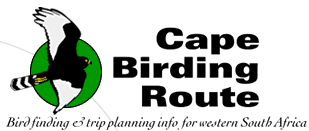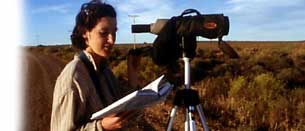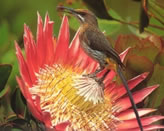|
|
Swartberg
Pass:
For over a century, the 24-km length of the Swartberg Pass has
connected the Little Karoo ostrich capital of Oudtshoorn to
the placid Great Karoo town of Prince Albert. As you head north
from Oudtshoorn and the road begins to climb, there is a sudden
switch from arid scrub and ravine-side thicket to moist, mist-wreathed
mountain fynbos. The pass crests the Swartberg range at an altitude
of 1 436 m before dropping precipitously through a series of
dramatic switchbacks, ingeniously supported by dry-stone walls.
Becoming progressively more arid, the road emerges into the
Karoo proper through a kloof presided over by agonizingly contorted
rock layers folded by massive early geological upheavals.
To
reach the pass, take the R328 from Oudtshoorn, and follow
the signs. You might like to spend a moment investigating
the dry hillside scrub in the vicinity of the Cango Mountain
Resort turn-off (24 km north of Oudtshoorn) where, among others,
Layard’s Titbabbler and Fairy Flycatcher
may be found. By the time the pass proper begins (where the
road surface changes to gravel, 43 km north of Oudtshoorn),
the altitude has rapidly transformed the parched scrub into
moist, dense mountain fynbos. The distances given are measured
from the end of the tarred road at this point; those in brackets
are measured from the beginning of the tarred road on the
other side of the pass, 2 km from Prince Albert. At 0.5 (25.5)
km past the transition to gravel, a stream flanked by taller
vegetation passes under the road. This is an excellent site
for Protea
Canary (p.57*); look particularly in the tall streamside
growth, and in the adjacent stands of Waboom (Protea nitida,
a tall, greyish-leafed protea). Protea
Canary is in fact common in taller vegetation on both
sides of the pass. More conspicuous species to be found in
this vicinity are Cape
Sugarbird (p.33*), Orange-breasted
Sunbird (p.33*), Neddicky, Cape Bulbul,
Grassbird and Malachite Sunbird. Victorin’s
Warbler is very common in the impenetrable undergrowth,
supported by seeps, along the entire ascent of the pass (from
here to the summit); look for them at the streams at 3.8 (22.2),
5.0 (21.0) and 7.3 (18.7) km. As the road approaches its highest
altitude, the terrain becomes ever-rockier and cooler. The
rocky ridges to the east and west of the pass’s summit
at 9.2 (16.8) km (‘Die Top’) are well worth a walk
in quest of Ground
Woodpecker (p.105*), Cape
Rockjumper (p.73*), Sentinel and Cape Rock
Thrushes and Cape
Siskin (p.33*)
North
of the summit, the landscape is noticeably drier, revealing
spectacular geological contortions. Keep an eye out for classic
mountain raptors such as Black and Booted Eagles,
Jackal Buzzard and Rock Kestrel. The road descends
through progressively more arid country and ultimately joins
a river in a dry gorge, at 22.2 (3.8) km. The hillside scrub
flanking it hosts such typically kloof-loving Karoo species
as Fairy Flycatcher, Layard’s Titbabbler
and, usually flying overhead, Pale-winged Starling.
At 25.7 (0.3) km, a picnic site lies on the left hand side
alongside a band of fearsomely thorned acacia trees. This
thicket offers Southern Tchagra, Pririt
Batis (p.85*), Namaqua
Warbler (p.85*) and Red-billed Firefinch, the
latter near the western limit of its range. From the junction
at 26.0 (0.0) km, the roads runs for 2 km through a broad
valley to the sleepy town of Prince Albert and the Great Karoo
beyond.
|
This website is maintained by Birding Africa.
Please do not use any text, images or content from this site without
permission.
© Birding Africa 1997-2009 info@capebirdingroute.org
4 Crassula Way, Pinelands, 7405, Cape Town, South Africa
|

27/09/09: Dalton
Gibbs reports back from Gough
Island! Read the blog!
26/09/09: New Cape
Town Pelagics trip report from trips of 12 and 19 September
2009.
30/08/09: British
Birdwatching Fair at Rutland Water proved very successful,
with sunny weather and over 20,000 visitors. Callan's "Birding
Namibia and the Okavango" was the most highly-attended
lecture on the Saturday, with over 240 people. Congratulations
to the winners of the Birding Africa competition and the
African Bird Club raffle that we helped sponsor!
12/08/09: New Cape
Town Pelagics trip reports from August and July 2009.
Highlights: Little
Shearwater and more!
07/08/09: The
sub-adult Black Sarrowhawk visits our garden again! Read
on about Raptor Research in the Western Cape.
27/07/09: Cape
Town's Verreauxs' Eagle Chick has grown! And its sibling
never had a chance to hatch. See the pictures of the chick,
its nest and the breeding pair. Find out more about the Western
Cape Raptor Research Programme.
27/07/09: To follow modern nomenclature and systematics, we've
adopted the IOC
World Bird List, Version 2.1.
13/07/09: The 8th
African Bird ID Challenge has launched! Win a 50% discount
on a Cape Town Pelagics
trip, a copy of Southern
African Birdfinder, or African
Bird Club membership for 1 year.
6 July 09: Cape
White-eye research in our garden.
2 July 09: Cape
Town's Verreauxs' Eagle Chick has hatched! See the pictures
of the chick, its nest and the breeding pair. Find out more
about the Western Cape Raptor Research Programme.
2 July 09: Campbell
Fleming, a Cape Town scholar, avid birder and photographer,
joined Birding Africa last month as an intern. Click here,
to see what he got up to.
2 July 09: New pelagic
trip reports from the Cape Town Pelagics trips in June
2009. Highlights: Slenderbilled
Prion and Leach's Storm Petrel
30 july 09: Our latest Cape Fynbos and Karoo trip
reports feature Hottentot
Buttonquail, Cinnamon-breasted
Warbler and other fynbos and Karoo endemics...
26 June 09: Tungsten
mining threatens RAMSAR site, South Africa's Verlorenvlei.
Read the Media Release.
22 June 09: Claire
Spottiswoode, one of the Cape Birding Route founders,
was part of the exploratory team at Mount Mabu. The mountain
is part of the newly discovered largest
rainforest in Southern Africa.
11 June 09: A colour-ringed
Black Sparrowhawk visits the Birding Africa office garden.
Read why it's a 10 months old male!
14 June 09:
Wildlife
at the office of The Cape Birding Route, Birding Africa
and Cape Town Pelagics.
31 May 09:
Michel Watelet wins the 7th African Bird Club & Birding Africa
ID Challenge. Test your African birding skills and WIN
a Birding
Africa Cape town day trip or a copy of the Birdfinder!
30 May 09:
A tragedy unfolds at Kommetjie south of Cape town as 44 beached
False
Killer Whales were shot. Click here for more details and
pictures.
14 March 09: Raptor
Watch in Cape Town on 14 March 09
|
|


